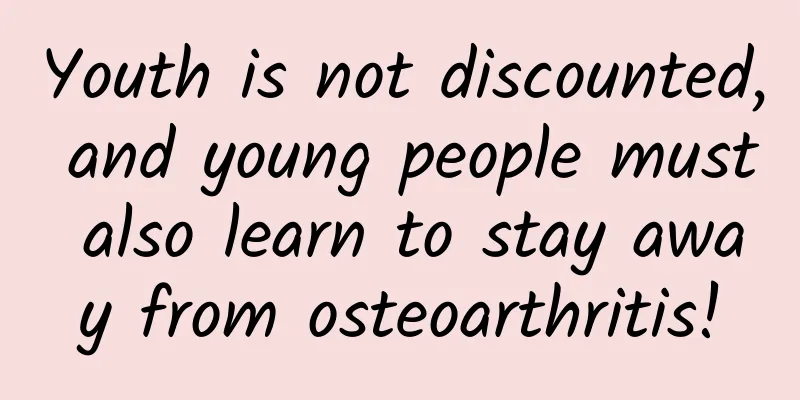Youth is not discounted, and young people must also learn to stay away from osteoarthritis!

|
Author: Cao Jiangang, Chief Physician of Tianjin Hospital Reviewer: Chen Desheng, Chief Physician of Tianjin Hospital Osteoarthritis is a degenerative disease of articular cartilage caused by various reasons. Compared with middle-aged and elderly people, young people seem to be less likely to suffer from osteoarthritis, but some lifestyle habits, exercise methods and potential joint problems can also increase the risk of osteoarthritis in young people. Therefore, young people should also pay attention to joint health management and actively prevent osteoarthritis. Figure 1 Copyright image, no permission to reprint 1. Risk factors for osteoarthritis in young people Although osteoarthritis is considered an elderly disease by most people, many young people may be affected by various reasons and develop the disease at an early age. The following are common risk factors for young people to develop osteoarthritis. 1. Excessive or improper exercise Exercise is good for the body, but improper exercise or overtraining may cause damage to the joints. Many young people, especially athletes and fitness enthusiasts, are prone to premature wear of joint cartilage due to high-intensity or irregular exercise. For example, frequent running, jumping or weightlifting may increase the burden on the knee and ankle joints, especially when not warming up or wearing appropriate protective gear, which can easily damage the joints. Figure 2 Copyright image, no permission to reprint 2. Obesity or overweight Overweight has a significant impact on joints, especially knee and hip joints, which increases the mechanical pressure on joints and leads to premature cartilage degeneration. Although young people have a stronger ability to repair joints, long-term high loads will gradually accumulate damage, thereby increasing the risk of osteoarthritis. 3. History of joint injury or surgery If you have had joint injuries (such as anterior cruciate ligament tear, meniscus injury, etc.) or joint surgery in your youth, you are more likely to suffer from osteoarthritis. Such injuries will affect joint stability and cartilage health, making joints more susceptible to degeneration. Figure 3 Copyright image, no permission to reprint 4. Occupational factors Certain occupations require long-term standing, heavy physical labor, or repeated knee bending movements, which increase the risk of osteoarthritis in young people. For example, occupational groups such as construction workers and couriers may accelerate cartilage wear due to long-term high load on their joints. 5. Genetic factors Although heredity is not the main cause of osteoarthritis in young people, people with a family history of osteoarthritis have a relatively higher risk of the disease. This group of people needs to pay more attention to joint protection and avoid bad living habits. 2. How can young people correctly deal with risk factors? When young people find themselves with the above risk factors, they can take the following measures to cope. 1. Adjust your exercise method If you are a young person who is keen on fitness or sports, it is recommended that you first learn the correct exercise techniques and avoid long-term high-impact exercise (such as long-term running, jumping or weightlifting). You can choose some low-impact exercises (such as swimming, cycling, etc.), which can effectively exercise the body without causing excessive burden on the joints. In addition, you should fully warm up before each exercise to avoid injuries due to unprepared joints. 2. Control your weight Controlling your weight is one of the effective ways to prevent osteoarthritis. Even if young people have a faster metabolism, they should avoid the risk of long-term joint damage caused by obesity. Maintaining your weight and reducing mechanical stress on your joints through a reasonable diet and moderate exercise are important steps to prevent premature degeneration of articular cartilage. 3. Early treatment and rehabilitation If you have ever had a joint injury, especially injuries to ligaments, meniscus and other structures, you should receive rehabilitation treatment as soon as possible under the guidance of a doctor. Ignoring early injuries will lead to long-term joint instability and eventually develop into osteoarthritis. After the injury, you should receive professional rehabilitation training as soon as possible and strengthen the surrounding muscles through physical therapy to effectively reduce joint pressure and prevent further degeneration of the joint. 4. Use protective gear Young people who engage in high-intensity work or sports can use appropriate protective gear, such as knee pads, wrist guards, etc. These protective gear can reduce joint stress during exercise or work, provide additional support and protection, but it is not recommended to wear them for a long time. Figure 4 Copyright image, no permission to reprint 5. Check joint health regularly. Young people with a family history of osteoarthritis or who have had joint injuries should undergo regular joint examinations to detect potential signs of joint degeneration early. Early examination and intervention can effectively prevent the development of osteoarthritis. 3. Strategies for early prevention of osteoarthritis in young people Early prevention is the key to avoiding osteoarthritis. Young people should start from all aspects of life to comprehensively maintain joint health. 1. Strengthen muscle strength training Strong muscles can reduce the burden on joints, especially the muscles around the knee joints. Young people can strengthen the muscles of the legs and hips through strength training to provide better support for the joints. Simple squats and bridge exercises can effectively exercise the lower limb muscle groups and help share the pressure on the joints. 2. Maintain joint flexibility. Young people often neglect flexibility training, but maintaining joint flexibility helps prevent joint stiffness and injury. Young people can maintain joint mobility through yoga and stretching exercises. Figure 5 Copyright image, no permission to reprint 3. Maintain a moderate amount of exercise. Although exercise is good for joint health, excessive exercise will increase the risk of joint injury and wear. Therefore, young people should control the intensity and duration of exercise and avoid overtraining. 4. Supplement nutrients that are beneficial to joint health. Bone and joint health cannot be separated from the support of nutrients. Young people should consume foods rich in calcium, vitamin D, collagen and omega-3 fatty acids. These nutrients can help maintain joint lubrication, reduce inflammatory responses, and enhance cartilage repair ability. IV. Treatment and health care of early osteoarthritis If young people have already shown early symptoms of osteoarthritis, timely measures should be taken to delay the progression of the disease and improve their quality of life. 1. Patients with early-stage osteoarthritis may experience mild joint pain or discomfort. The use of nonsteroidal anti-inflammatory drugs can relieve pain and reduce inflammatory responses, but long-term use should be avoided. It is recommended to take the drug in the short term as prescribed by a doctor. 2. Physical therapy and rehabilitation Physical therapy can strengthen the muscles around the joints, restore joint mobility, and relieve pain. Early osteoarthritis patients can maintain joint health and delay disease progression through physical therapy and exercise training. 3. Adjust your daily habits In daily life, young people should avoid standing for long periods of time or repeatedly engaging in weight-bearing activities. They should also pay attention to adjusting their postures when working and resting to avoid excessive load on their joints. In addition, arranging work and exercise time reasonably and giving the joints enough time to recover are also important measures to delay joint degeneration. 4. Use joint protection devices. Using knee pads, ankle pads and other auxiliary tools can effectively reduce joint load and protect joints that have already shown early symptoms from further damage. Young people who engage in heavy physical labor or exercise can appropriately use these auxiliary tools to reduce joint pressure and prevent the condition from worsening. The onset of osteoarthritis is a long-term cumulative process. Although the joint cartilage is relatively healthy and has a strong ability to recover during youth, if potential risk factors are ignored, cartilage wear and joint degeneration will also occur quietly. The key to preventing osteoarthritis is to take action early, starting with adjusting lifestyle, exercising properly, controlling weight, protecting joints, etc. It should be emphasized that joint damage is often irreversible. Once symptoms appear, treatment and rehabilitation should be carried out as soon as possible to avoid surgical treatment due to worsening of the disease. Through scientific exercise, reasonable nutritional supplements, and maintaining a healthy lifestyle, young people can fully maintain the long-term health of their joints, delay the occurrence of osteoarthritis, and enjoy a high-quality life. Figure 6 Copyrighted images are not authorized for reproduction |
<<: Knee pain in the elderly? The truth about osteoarthritis revealed!
>>: Prevention and treatment of diabetic retinopathy
Recommend
Can I have an abortion if I have anemia?
In modern society, as people's sexual concept...
How long after a miscarriage can you not have sex?
The most common patients in the hospital are of v...
Are there blue chrysanthemums? What colors are chrysanthemums?
Honey has the effects of anti-inflammatory, expec...
What is gynecological purulent leucorrhea?
If you have leucorrhea with curd residue, you sho...
What are the taboos of eating durian thousand-layer cake? What can't be eaten with durian cake?
Durian is a well-known tropical fruit that contai...
Treatment methods for vulvar atrophy
Vulvar atrophy is a female disease, it is not a g...
Why do women have pain on both sides of their lower abdomen?
Lower abdominal pain may be a very common symptom...
Girl has dull pain on the right side of her stomach
There are many reasons why girls feel a dull pain...
What causes itchy belly during early pregnancy?
Women may often feel itchy in the abdomen during ...
What should I do if there is bleeding after my period?
I believe that in daily life, many people must ha...
How to maintain the motorcycle chain? What to use to clean the motorcycle chain?
Motorcycles are also a means of transportation fo...
Is the afternoon pregnancy test more accurate?
Female friends should be very familiar with pregn...
Will cervical polyps recur?
Cervical cyst is actually a very common cervical ...









